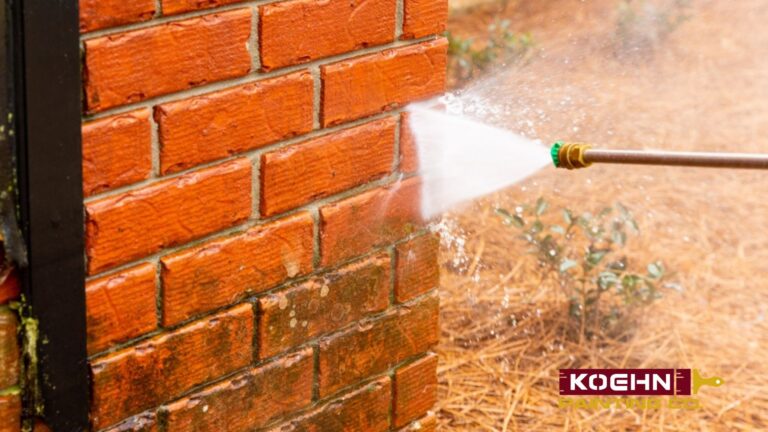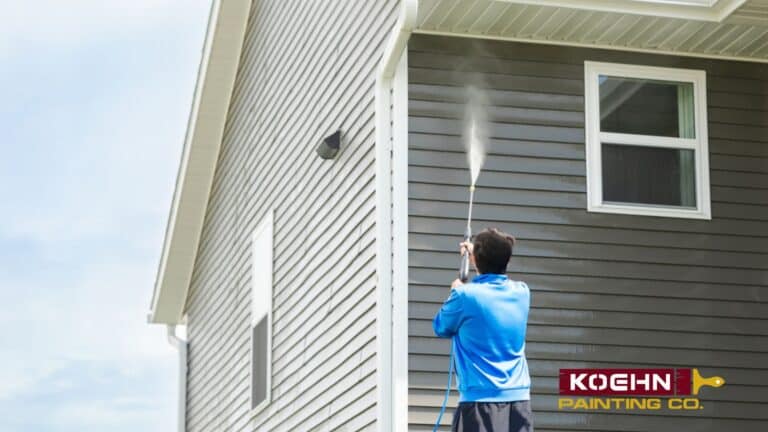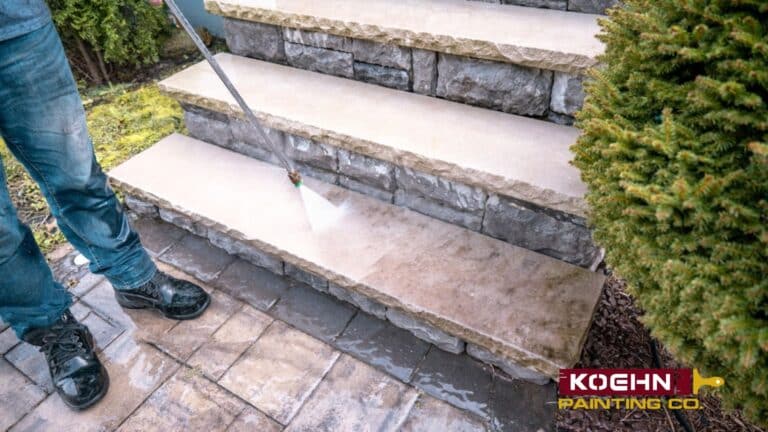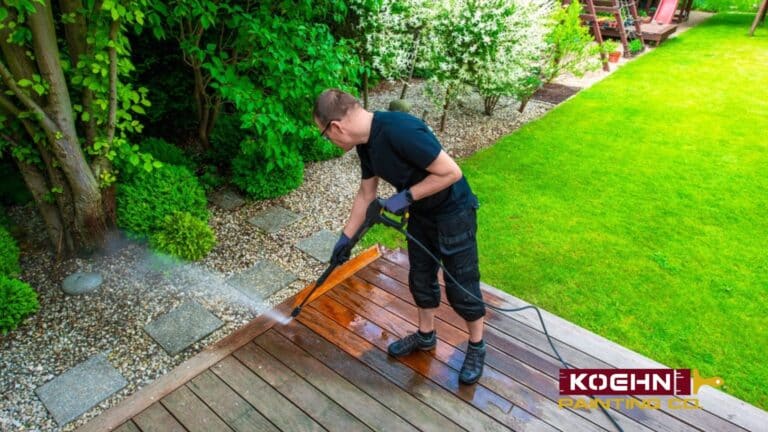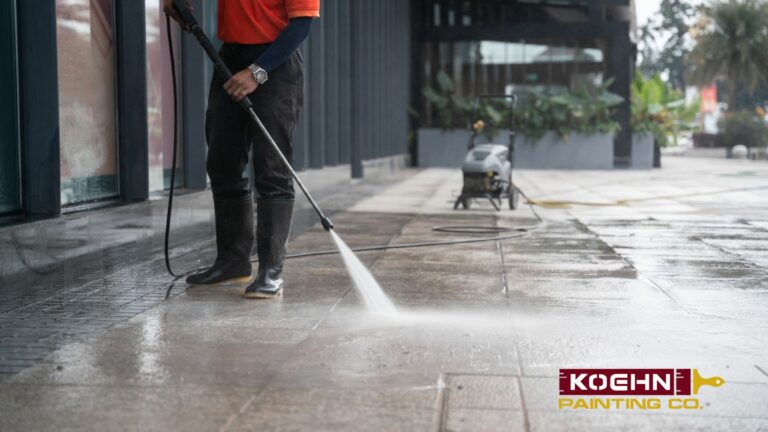Can Pressure Washing Damage Concrete?
Can pressure washing damage concrete? Pressure washing and power washing, while effective for cleaning concrete surfaces, both carry inherent risks. The main distinction lies in the use of heat: power washing utilizes heated water, making it highly efficient at breaking down oil, mildew, and grime.
However, this heat can also weaken concrete sealants and increase the likelihood of water absorption, leading to issues such as etching, freeze-thaw damage, and surface wear. Pressure washing, on the other hand, uses unheated water at high pressure.
While generally safer for routine maintenance, it still poses a threat if the PSI is too high, the nozzle angle is too narrow, or the wand lingers on one spot. The method selected must match the condition and needs of the concrete to avoid unintended damage.
Driveways are the most common surfaces for pressure washing, and also where mistakes are most visible. Improper technique can lead to etching, pitting, and unsightly “zebra stripes.” Similar risks exist for sidewalks, patios, pool decks, and garage floors, where improper use can exacerbate surface vulnerabilities.
To pressure wash safely, preparation is essential:
- Check the concrete for existing damage,
- Choose the correct PSI and nozzle,
- Keep a sweeping, even motion during cleaning,
- Sealing after washing is also important to protect the surface from moisture and stains.
For complex or compromised surfaces, professional help is recommended. Ultimately, successful pressure washing hinges on control and technique, not raw power. When done correctly, it can revitalize concrete surfaces and extend their lifespan without causing damage.
Let’s dive deepr into this topic:
Can Power Washing Damage Concrete?

So, two questions are rolling around: can power washing damage concrete? And, can pressure washing damage concrete? The short answer is: both methods carry risk. The difference comes down to one key detail: heat.
Power washing uses hot water, which helps break down stubborn oil, mildew, and grime more efficiently. Great for heavy-duty cleaning, but it also ups the risk of harm, especially if your concrete is older, sealed, or surface-worn.
Think of it this way: heat loosens grime, but it can also soften or weaken protective layers—like sealants—on your concrete. That opens the door to etching, water intrusion, and even freeze-thaw damage, especially in cooler climates.
Meanwhile, cold-water pressure washing provides raw power without the thermal boost. This makes it safer for routine maintenance, but that same force can still damage a surface if your PSI is too high, you stay too long, or you use a narrow-angle nozzle.
So yes, both methods carry risk. The real question is how much pressure and temperature your specific concrete can handle, and whether you’re equipped to dial it in correctly. Let’s break it down further.
Pressure Washing vs. Power Washing Concrete (and When It Turns Harmful)
At first glance, “pressure washing” and “power washing” seem like the same thing. Both use a high-powered water spray to remove dirt, stains, and buildup. However, there’s a subtle yet significant difference that affects the risks involved.
Pressure washing:
- Uses unheated water delivered at adjustable PSI.
- Works well for most routine cleaning: sidewalks, patios, pool decks, and general buildup.
- The main danger comes from force alone. Too much PSI, the wrong nozzle, or holding the wand too close can etch or stripe concrete.
- Ideal for routine maintenance when you need safe cleaning that doesn’t involve heat.
Power washing:
- Uses heated water in addition to high pressure.
- The heat helps break down grease, oil stains, mildew, and salt deposits more effectively than cold water.
- Power washing with hot water can loosen sealants and cause water absorption, which may lead to freeze-thaw damage in cold climates.
- Typically reserved for heavy-duty jobs like garage floors caked with oil, driveways covered in years of grime, or commercial surfaces exposed to tough buildup.
So, when does cleaning become destructive? Well, damage doesn’t stem from the tool itself; it’s caused by how it’s used. Issues like surface etching, pitting, or stripped sealants usually occur when:
- The PSI is set too high for the surface.
- A narrow-angle nozzle concentrates force in one line.
- The user lingers too long in a single spot.
- The surface is already compromised—old, cracked, or poorly sealed.
In short, pressure washing relies solely on force, while power washing incorporates heat. Both can be effective, but both also pose risks. The key is knowing which method suits your concrete’s condition and setting boundaries to prevent damage.
Contact us here if you would like to find the best painting contractor for your residential or commercial painting needs.
Driveway Pressure Washing and Beyond: Where Pressure Cleaning Matters Most

When people picture pressure washing, the first surface that comes to mind is almost always the driveway. And it makes sense: driveway pressure washing can take a surface that’s stained, faded, and lifeless and restore it in a matter of hours. Tire marks, oil drips, and road grime are stubborn, and a simple garden hose won’t even scratch the surface. A well-executed driveway wash can instantly lift a property’s curb appeal and even extend the lifespan of the concrete.
But here’s the catch: driveways are also where DIY mistakes show up the fastest. Concrete that looks solid can actually be susceptible to etching, pitting, or stripped sealant if the washer is used incorrectly. In fact, many of the “zebra stripes” people complain about after washing come from jobs gone wrong right on the driveway.
It’s often at this stage that homeowners wonder, “Can I use a pressure washer on concrete safely?” The answer remains yes, but only when paired with the right technique. So while the results can be rewarding, driveways are also the surface where the question “can pressure washing damage concrete?” and “can power washing damage concrete?” becomes very real.
And it’s not just driveways. Other areas around the property face the same balance between benefit and risk:
- Sidewalks can become dangerously slick with algae, but too much pressure can pit their already thin surface.
- Patios and decks often trap mildew or food stains, yet decorative finishes make them more sensitive to pressure.
- Pool decks benefit from cleaning for safety, but repeated washing without sealing leaves them porous and prone to water damage.
- Garage floors pick up grease and salt that pressure washing removes well, but aggressive washing may open micro-cracks to more wear.
Driveway pressure washing may be the most common project, but it’s also a cautionary example. Every surface has its quirks, and knowing when to adjust your approach is the only way to avoid expensive mistakes.
That leads to the bigger question every homeowner asks: “How do you pressure wash without damaging concrete?” The answer lies in understanding your surfaces, your settings, and your limits, which is exactly what we’ll cover next.
Step-by-Step: How to Pressure Wash Concrete Without Damage
By now, it’s clear that both pressure washing and power washing carry risks. However, that doesn’t mean you should avoid them entirely. When used correctly, these tools can make your concrete look brand new without leaving behind etching, streaks, or cracks.
The key is to follow a methodical process, and for that, here’s a step-by-step guide to doing it safely.
1. Prep for success
Every great project starts with preparation. Before firing up the machine, take time to get the surface—and yourself—ready.
- Inspect and repair: Look for cracks, chips, or areas of loose concrete. These weak spots can worsen under high pressure, so patch them first.
- Clear the area: Move furniture, vehicles, and debris. Cover plants, windows, or siding to protect them from overspray.
- Gear up: Safety glasses, long pants, and sturdy shoes aren’t optional; they’re your protection against flying debris and high-pressure spray.
Taking a few minutes to prep prevents most of the accidents and regrets that DIYers run into later.
2. Pick the right pressure and nozzle
Not all washers and nozzlers are the same. The settings you choose will determine whether you get a flawless clean or permanent damage.
- For most driveways, 2,500 PSI is often effective, but start lower and increase only if necessary.
- Choose a 25°–40° nozzle for an even spray. Avoid 0° nozzles since they act like chisels, not cleaners.
- Keep a safe distance: Aim for 12–24 inches between the nozzle and the surface.
The right combo of PSI and nozzle angle gives you cleaning power without the scars.
3. Master the cleaning technique
Once you’re set up, the technique is what separates professional-looking results from rookie mistakes.
- Pre-treat stubborn stains with a concrete detergent. Let it dwell before rinsing so you don’t have to rely only on raw pressure.
- Work in sweeping strokes: Move in overlapping passes, keeping the wand in motion to avoid striping.
- Rinse thoroughly after washing so dirt and detergent don’t settle back into pores.
Most damage comes not from the machine, but from pausing too long or using short, jerky passes. Slow, steady strokes keep your concrete safe.
4. Dry and seal for long-term protection
Cleaning is only half the battle; sealing is what locks in your results.
- Allow it to dry completely for at least 24 hours, or longer if humidity is high.
- Choose the right sealer: Acrylic or penetrating sealers are suitable for patios and driveways; epoxy or polyurethane are better options for garages.
- Apply in thin, even coats; two coats are usually best.
Unsealed concrete reabsorbs moisture, oil, and dirt quickly, undoing your hard work.
5. Accept it when it’s time to call a pro
Sometimes, the smartest move isn’t DIY. If your concrete is decorative, heavily stained, or riddled with cracks, professional cleaners have the experience—and the equipment—to do the job without causing damage. Pros also handle heated power washing, large areas, or sealing that requires specialized products.
A weekend project should save you money, not cost you repairs. If you’re unsure, let an expert step in.
So, how do you pressure wash without damaging concrete? The answer isn’t more power; it’s more control. From prep to sealing, every step adds a layer of protection for your surfaces. Follow the process, respect your concrete’s limits, and you’ll enjoy a clean, durable finish without the costly side effects.
Can Pressure Washing Damage Concrete? Final Thoughts and Recommendations

So, can pressure washing damage concrete? The honest answer is yes, but only if it’s done carelessly.
Too much PSI, the wrong nozzle, or neglecting to prepare the surface can leave you with etching, stripes, or weakened concrete. The same applies to power washing: heat may cut through grease and oil, but it can also break down sealants and worsen small cracks. In other words, the tool itself isn’t the problem; the technique is.
The good news is that when handled properly, pressure washing is one of the most effective ways to clean and protect your property. From driveway pressure washing to patios, sidewalks, and garage floors, the key is adjusting your settings, keeping the wand in motion, and sealing the surface afterward.
If you’re unsure, or if your concrete is decorative or already damaged, calling in a professional can save you time and prevent costly mistakes. Done correctly, pressure washing not only restores your concrete but also helps extend its lifespan.
FAQs: Everything You Wonder About Pressure Washing Concrete
1. How do you pressure wash without damaging concrete?
Start with 2,500–3,000 PSI, use a 25°–40° fan nozzle, keep the wand sweeping in motion, and avoid lingering in one spot.
2. How to fix damaged concrete from a pressure washer?
Minor streaks or uneven patches might be hidden by uniform etching, but deeper etching and chipping typically require professional concrete refinishing.
3. Can I use a pressure washer on concrete?
Yes, concrete is durable enough, but only if you adjust the PSI and technique properly, especially on new or decorative surfaces.
4. What is one thing you should never do with the pressure washer?
Never use a highly concentrated nozzle like a 0° tip on concrete; it behaves like a chisel and can cause permanent damage.
5. Does power washing erode concrete?
If misused, hot water power washing can soften sealants and accelerate deterioration, especially on older or sealed surfaces.
6. Can you repair badly damaged concrete?
Severe damage like deep chipping often requires surface grinding or complete resurfacing—DIY quick fixes won’t do the job safely.
7. When should you not use a pressure washer?
Avoid pressure washing new concrete until it has cured for at least 28 to 60 days. Fully cured, older concrete is safer to wash.
8. What are the damages of pressure washing? Common issues include etched or striped surfaces, sealant stripping, micro-cracking, and, in severe cases, chipping or weakened structure.
9. What are the cons of pressure washing?
Risks include surface damage, water intrusion, equipment misuse, and safety hazards, especially if used improperly or without proper safety measures.

